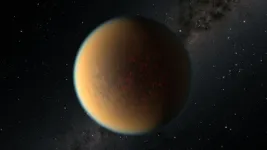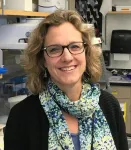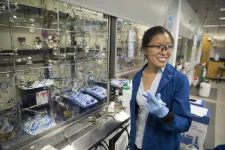(Press-News.org) The planet GJ 1132 b appears to have begun life as a gaseous world with a thick blanket of atmosphere. Starting out at several times the radius of Earth, this so-called "sub-Neptune" quickly lost its primordial hydrogen and helium atmosphere, which was stripped away by the intense radiation from its hot, young star. In a short period of time, it was reduced to a bare core about the size of Earth.
To the surprise of astronomers, new observations from Hubble [1] have uncovered a secondary atmosphere that has replaced the planet's first atmosphere. It is rich in hydrogen, hydrogen cyanide, methane and ammonia, and also has a hydrocarbon haze. Astronomers theorise that hydrogen from the original atmosphere was absorbed into the planet's molten magma mantle and is now being slowly released by volcanism to form a new atmosphere. This second atmosphere, which continues to leak away into space, is continually being replenished from the reservoir of hydrogen in the mantle's magma.
"This second atmosphere comes from the surface and interior of the planet, and so it is a window onto the geology of another world," explained team member Paul Rimmer of the University of Cambridge, UK. "A lot more work needs to be done to properly look through it, but the discovery of this window is of great importance."
"We first thought that these highly radiated planets would be pretty boring because we believed that they lost their atmospheres," said team member Raissa Estrela of the Jet Propulsion Laboratory at the California Institute of Technology in Pasadena, California, USA. But we looked at existing observations of this planet with Hubble and realised that there is an atmosphere there."
"How many terrestrial planets don't begin as terrestrials? Some may start as sub-Neptunes, and they become terrestrials through a mechanism whereby light evaporates the primordial atmosphere. This process works early in a planet's life, when the star is hotter," said team leader Mark Swain of the Jet Propulsion Laboratory. "Then the star cools down and the planet's just sitting there. So you've got this mechanism that can cook off the atmosphere in the first 100 million years, and then things settle down. And if you can regenerate the atmosphere, maybe you can keep it."
In some ways, GJ 1132 b has various parallels to Earth, but in some ways it is also very different. Both have similar densities, similar sizes, and similar ages, being about 4.5 billion years old. Both started with a hydrogen-dominated atmosphere, and both were hot before they cooled down. The team's work even suggests that GJ 1132 b and Earth have similar atmospheric pressure at the surface.
However, the planets' formation histories are profoundly different. Earth is not believed to be the surviving core of a sub-Neptune. And Earth orbits at a comfortable distance from our yellow dwarf Sun. GJ 1132 b is so close to its host red dwarf star that it completes an orbit the star once every day and a half. This extremely close proximity keeps GJ 1132 b tidally locked, showing the same face to its star at all times -- just as our moon keeps one hemisphere permanently facing Earth.
"The question is, what is keeping the mantle hot enough to remain liquid and power volcanism?" asked Swain. "This system is special because it has the opportunity for quite a lot of tidal heating."
The phenomenon of tidal heating occurs through friction, when energy from a planet's orbit and rotation is dispersed as heat inside the planet. GJ 1132 b is in an elliptical orbit, and the tidal forces acting on it are strongest when it is closest to or farthest from its host star. At least one other planet in the host star's system also exerts a gravitational pull on the planet. The consequences are that the planet is squeezed or stretched by this gravitational "pumping." That tidal heating keeps the mantle liquid for a long time. A nearby example in our own Solar System is the Jovian moon, Io, which has continuous volcanism as a result of a tidal tug-of-war between Jupiter and the neighbouring Jovian moons.
The team believes the crust of GJ 1132 b is extremely thin, perhaps only hundreds of feet thick. That's much too feeble to support anything resembling volcanic mountains. Its flat terrain may also be cracked like an eggshell by tidal flexing. Hydrogen and other gases could be released through such cracks.
"This atmosphere, if it's thin -- meaning if it has a surface pressure similar to Earth -- probably means you can see right down to the ground at infrared wavelengths. That means that if astronomers use the James Webb Space Telescope to observe this planet, there's a possibility that they will see not the spectrum of the atmosphere, but rather the spectrum of the surface," explained Swain. "And if there are magma pools or volcanism going on, those areas will be hotter. That will generate more emission, and so they'll potentially be looking at the actual geological activity -- which is exciting!"
This result is significant because it gives exoplanet scientists a way to figure out something about a planet's geology from its atmosphere," added Rimmer. "It is also important for understanding where the rocky planets in our own Solar System -- Mercury, Venus, Earth and Mars, fit into the bigger picture of comparative planetology, in terms of the availability of hydrogen versus oxygen in the atmosphere."
INFORMATION:
Notes:
[1] The observations were conducted as part of the Hubble observing program #14758 (PI: Zach Berta-Thomson).
More information:
The Hubble Space Telescope is a project of international cooperation between ESA and NASA.
The team's findings will be published in an upcomming issue of The Astronomical Journal.
The international team of astronomers in this study consists of M. R. Swain, R. Estrela, G. M. Roudier, C. Sotin, P. Rimmer, A. Valio, R. West, K. Pearson, N. Huber-Feely, and R. T. Zellem.
Image credit: NASA, ESA, and R. Hurt (IPAC/Caltech)
Breast cancer is harmful enough on its own, but when cancer cells start to metastasize -- or spread into the body from their original location -- the disease becomes even more fatal and difficult to treat.
Thanks to new research published in Oncogene from the lab of University of Colorado Cancer Center associate director of basic research Heide Ford, PhD, in collaboration with Michael Lewis, PhD, from Baylor College of Medicine, doctors may soon have a better understanding of one mechanism by which metastasis happens, and of potential ways to slow it down.
"Metastasis is a huge problem nobody's tackled very well," says Ford, who ...
The universe is filled with magnetic fields. Understanding how magnetic fields are generated and amplified in plasmas is essential to studying how large structures in the universe were formed and how energy is divided throughout the cosmos.
An international collaboration, co-led by researchers at the University of Rochester, the University of Oxford, and the University of Chicago, conducted experiments that captured for the first time in a laboratory setting the time history of the growth of magnetic fields by the turbulent dynamo, a physical mechanism thought to be responsible for generating ...
Optical-resolution photoacoustic microscopy (OR-PAM), a new hybrid imaging technique, allows us to listen to the sound of light and see the color of biological tissue itself. It can be used for live, multicontrast functional imaging, but the limited wavelength choice of most commercial lasers and the limitations of the existing scanning methods have meant that OR-PAM can obtain only one or two different types of contrast in a single scan. These limitations have made multicontrast functional imaging time-consuming, and it's been difficult to capture the ...
Ann Arbor, March 11, 2020 - Black and Hispanic people experience a higher risk for COVID-19 and severe illness, influenced by factors such as discrimination, housing, and healthcare access and utilization. Now, a END ...
CHAMPAIGN, Ill. -- The chronic stress of living in neighborhoods with high rates of violence and poverty alters gene activity in immune cells, according to a new study of low-income single Black mothers on the South Side of Chicago.
The changes in stress-related gene expression reflect the body's "hunker down" response to long-term threat, a physiological strategy for lying low and considering new actions rather than launching an immediate "fight-or-flight" response. This has implications for health outcomes in communities of color and other marginalized populations, said researchers at the University of Illinois Urbana-Champaign and collaborators at the University of Kentucky and UCLA. The researchers published the study in the journal Psychoneuroendocrinology.
"The ...
GAINESVILLE, Fla. --- The showy colors of some butterflies could advertise their speed and nimbleness, much like a coat of bright yellow paint on a sports car. A new study shows birds can learn to recognize these visual cues, avoiding not only butterflies they've failed to nab in the past but similar-looking species as well.
The research provides some of the strongest evidence to date for the idea of evasive mimicry, a strategy in which animals protect themselves from predators by matching the colors or patterns of agile relatives. First proposed more than 60 years ago, the hypothesis has been a challenge to test.
But in an experimental setting, ...
SAN ANTONIO -- Surgically opening the windpipe, or trachea, within the first seven days of the start of mechanical ventilation decreases the time patients spend on ventilators, shortens their ICU stay and lowers their risk of ventilator-associated pneumonia, according to a systematic review published Thursday (March 11) in JAMA Otolaryngology-Head & Neck Surgery.
"We analyzed the existing medical literature to unravel a question that is very pertinent to adult critical care," said senior author Alvaro Moreira, MD, MSc, of The University of Texas Health Science Center at San Antonio (UT Health San ...
The global battle against antibiotic resistance can only succeed if local contexts are taken into account. "A tailored approach is needed in each country," says Heiman Wertheim of Radboud university medical center. "There is no "one-size-fits-all' solution." This was the main finding of a study on antibiotic resistance in African and Asian countries funded by the British Wellcome Trust. Wertheim is the lead investigator of a large group of international researchers who recently published an article on this study in The Lancet Global Health.
Antibiotics are powerful treatments for bacterial infections. They are indispensable for controlling infections such as pneumonia, meningitis, or blood poisoning (sepsis) caused by bacteria. But they are ineffective for treating ...
Sugar has been called "evil," "toxic," and "poison." But the body needs sugars, too. Sugar molecules help cells recognize and fight viruses and bacteria, shuttle proteins from cell to cell, and make sure those proteins function. Too much or too little can contribute to a range of maladies, including neurodegenerative diseases like Alzheimer's, inflammation, diabetes, and even cancer.
About 85 percent of proteins, including those associated with Alzheimer's and Parkinson's, are beyond the reach of current drugs. One critical and abundant sugar (O-GlcNAc, pronounced o-glick-nack) is found on over 5,000 proteins, often those considered "undruggable." But now, researchers at Harvard University ...
Boston, MA - Vaccinating adults age 26 and older against the human papillomavirus (HPV)--the virus that causes more than 90% of cervical cancers as well as several other cancers--may not be cost-effective, according to a new study led by researchers at the Harvard T.H. School of Public Health.
"Our study found that the added health benefit of increasing the vaccination age limit beyond 26 years is minimal, and that the cost-effectiveness is much lower than in pre-adolescents, the target age group for the HPV vaccine," said Jane Kim, K.T. Li Professor of Health Economics and lead author of the study.
The study will be published March 11, 2021, in PLOS Medicine.
HPV vaccines have been shown to be highly effective in preventing ...




